Description
Median refuge islands are protected spaces placed in the center of the street to facilitate bicycle and pedestrian crossings. Crossings of two-way streets are facilitated by allowing bicyclists and pedestrians to navigate only one direction of traffic at a time. Medians configured to protect cycle tracks can both facilitate crossings and also function as two-stage turn queue boxes. See Two-Stage Turn Queue Boxes for guidance details.
For bicycle facility crossings of higher volume or multi-lane streets, increased levels of treatment may be desired including bicycle signals, hybrid beacons, or active warning beacons.
Click on the images below to view 3D concepts of conventional bike lanes. The configurations shown are based on San Luis Obispo, CA, Portland, OR, and New York, NY, examples.
Treatment details can be accessed below under
design guidance.
Median Refuge Island Benefits
- By simplifying crossings, allows bicyclists to more comfortably cross streets.
- Provides a protected space for bicyclists to wait for an acceptable gap in traffic.
- On two-way streets allows bicyclists to take advantage of gaps in one direction of traffic at a time.
- Reduces the overall crossing length and exposure to vehicle traffic for a bicyclist or pedestrian.
- Decreases the amount of delay that a bicyclist will experience to cross a street.
- Calms traffic on a street by physically narrowing the roadway and potentially restricts motor vehicle left turn movements.
- Establishes and reinforces bicycle priority on bicycle boulevards by restricting vehicle through movements.
- When used with a protected cycle track, raised medians can be installed at each side of the block to give structure to the floating parking lane.
- When used to protect a cycle track, raised medians can provide crossing pedestrians with a refuge area and/or provide shelter for a bicyclist making a two-stage turn across traffic.
Typical Applications
- Where a bikeway crosses a moderate to high volume or high speed street.
- Along streets with high bicycle and pedestrian volumes.
- Along streets with few acceptable gaps to cross both directions of traffic.
- At signalized or unsignalized intersections.
- Where it is desirable to restrict vehicle through movements, a median can double as a diverter to prevent cut-through traffic on a bicycle route.
- With protected cycle tracks.
Design Guidance
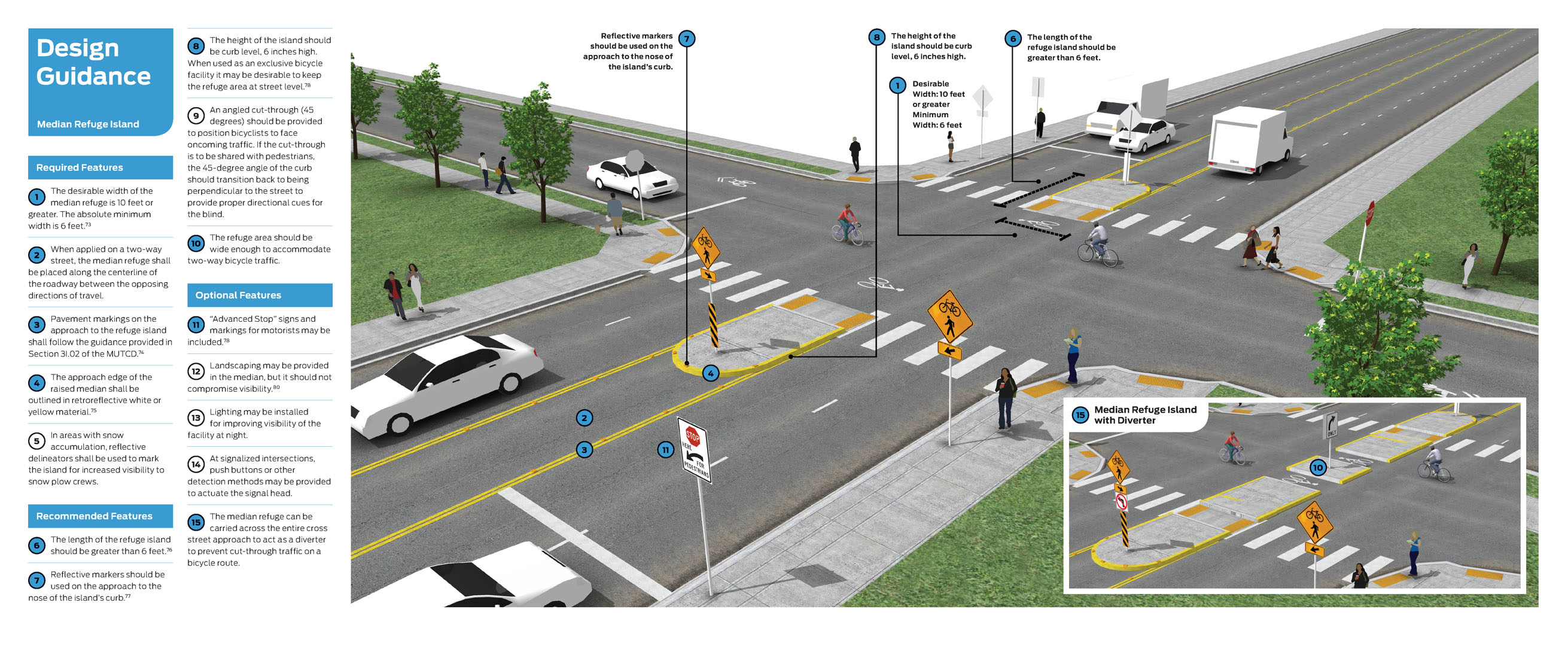
| Required Features |
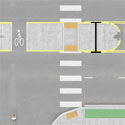 |
The desirable width of the median refuge is 10 feet or greater. The absolute minimum width is 6 feet. Read More+
Width of refuge:
2.0 m (6 ft) = poor
2.5 m (8 ft) = satisfactory
3.0 m (10 ft) = good
AASHTO. (1999). Guide for the Development of Bicycle Facilities. p.51-52.
|
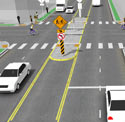 |
When applied on a two-way street, the median refuge shall be placed along the centerline of the roadway between the opposing directions of travel. |
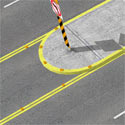 |
Pavement markings on the approach to the refuge island shall follow the guidance provided in Section 3I.02 of the MUTCD. Read More+
“The ends of the islands first approached by traffic should be preceded by diverging longitudinal pavement markings on the roadway surface, to guide vehicles into desired paths of travel along the islands edge. ”
Federal Highway Administration. (2009). Manual on Uniform Traffic Control Devices.
|
 |
The approach edge of the raised median shall be outlined in retroreflective white or yellow material. Read More+
“Retroreflective solid yellow markings should be placed on the approach ends of raised medians and curbs of islands that are located in the line of traffic flow where the curb serves to channel traffic to the right of the obstruction.”
“Retroreflective solid white markings should be used when traffic is permitted to pass on either side of the island.”
Federal Highway Administration. (2009). Manual on Uniform Trafic Control Devices. Section 3B.23.
|
 |
In areas with snow accumulation, reflective delineators shall be used to mark the island for increased visibility to snow plow crews. |
| Recommended Features |
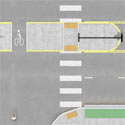 |
The length of the refuge island should be greater than 6 feet. Read More+
“Length of island should be 2 m (6 ft) or greater.”
AASHTO. (1999). Guide for the Development of Bicycle Facilities. p.51-52.
|
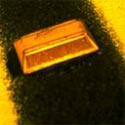 |
Reflective markers should be used on the approach to the nose of the island’s curb. Read More+
AASHTO. (2004). Geometric Design Guide of Highways and Streets.
|
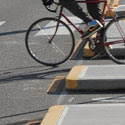 |
The height of the island should be curb level, 6 inches high. When used as an exclusive bicycle facility it may be desirable to keep the refuge area at street level. Read More+
AASHTO. (2004). Geometric Design Guide of Highways and Streets.
|
 |
An angled cut-through (45 degrees) should be provided to position bicyclists to face oncoming traffic.If the cut-through is to be shared with pedestrians, the 45-degree angle of the curb should transition back to being perpendicular to the street to provide proper directional cues for the blind. |
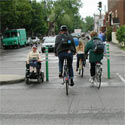 |
The refuge area should be wide enough to accommodate two-way bicycle traffic. |
Maintenance
- Refuge islands may collect road debris and may require somewhat frequent maintenance.
- Refuge islands should be visible to snow plow crews and should be kept free of snow berms that block access.
Treatment Adoption and Professional Consensus
- Commonly used in dozens of European bicycle friendly cities.
- Currently used in the following US cities:
- Austin, TX
- Los Angeles, CA
- Minneapolis, MN
- Portland, OR
- San Francisco, CA